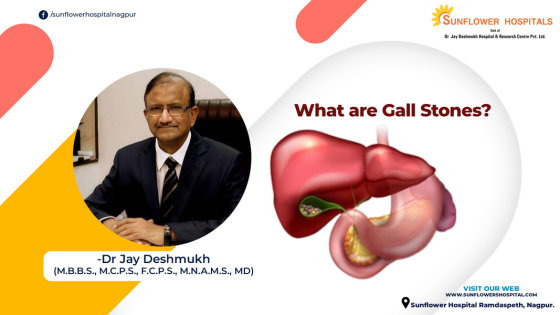What is the primary purpose of the gallbladder?
The primary purpose of the gallbladder is to store bile. It is a greenish-brown fluid that is produced by the liver. Bile carries waste products out of the liver but is also needed to digest and absorb fatty foods and to absorb important fat-soluble vitamins. In between meals, the gall bladder is relaxed allowing bile to flow into it to get stored and concentrated. With meals, the fat contained in food is sensed by the small intestine, causing the gallbladder to contract and partially empty into the intestine, a few hours later, the gallbladder relaxes and begins to store bile again.
What are gallstones?
They are solid concretions formed inside the gall bladder. The size may vary from sand-like particles to large stones. They could be single or multiple.
What are the two major types of gallstones?
They could be cholesterol or pigment stones. Cholesterol stones form up to 80% of gallstones. The other are pigment stones. Pigment stones are seen in individuals where there is excessive destruction of red blood cells, as in sickle cell disease.
How to treat gallstones?
In some, and wait-and-watch policy is warranted. Some medicines are given while preserving the gall bladder. In symptomatic cases, removal of gall bladder along with stones is recommended. This is commonly done by laparoscopic procedure.
What are the symptoms of gallstones?
The majority of gallstones do not cause symptoms. Their stones remain silent. Silent gall stones are often found on an ultrasound or CT scan done for some other purpose. Silent stones are not treated unless you are diabetic. Gallstone pain or biliary colic is the most common early symptom of gallstones. The pain may be a dull ache or severe, commonly occurring after meals. It is located just below the right rib cage. At times the pain may be felt in the centre of the abdomen or pain in the back in between shoulder blades, pain in the right shoulder, vomiting, fever, chills, intolerance to fatty meals, or pain in the upper abdomen or lower chest confusing it with cardiac pain. Once you have a first attack of biliary colic, there’s a good chance that you will have more symptoms in the future.
What are the complications of gallstones?
I could be cholecystitis which means inflammation of the gallbladder, it occurs when there is complete blockage of the gallbladder caused by gallstones. Pain is constant with acute cholecystitis and generally associated with fever and jaundice. Acute cholecystitis needs to be managed in a hospital with intravenous fluids, antibiotics, and pain-relieving medications. Surgery to remove stones along with the whole gallbladder is generally recommended.
What if gallstones migrate to the main bile ducts that enter the intestines?
This may lead to jaundice, infection of the bile duct, or cholangitis, which leads to fever, chills, and jaundice. This is a life-threatening condition that requires prompt treatment. Removal of stones from the bile duct is done by ERCP, which is a non-surgical procedure. Acute pancreatitis, which is a sudden inflammation of the pancreas, can occur. Acute pancreatitis is a serious condition.
Author: Dr Jay Deshmukh
Dr Jay Deshmukh is Chief Physician and Director, Sunflower Hospital, Nagpur Honorary Physician to Honorable Governor of Maharashtra and PondicherryCentral. Dr Jay Deshmukh is an M.B.B.S., M.C.P.S., F.C.P.S., M.N.A.M.S., MD From Internal Medicine – Bombay and New Delhi.


